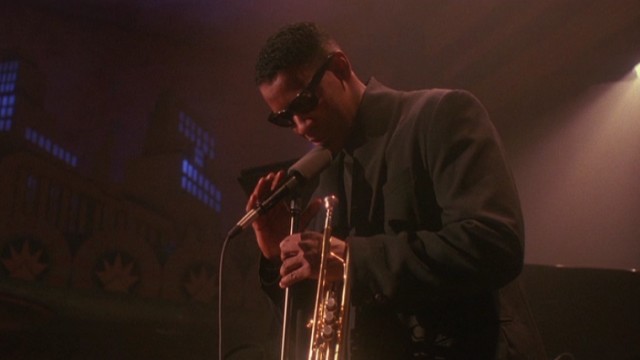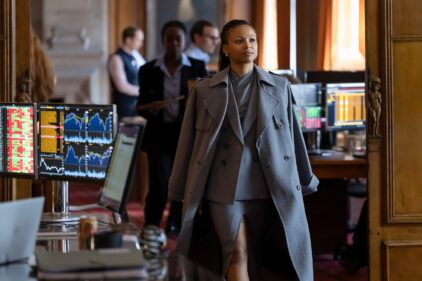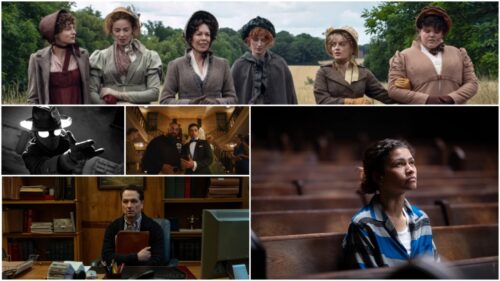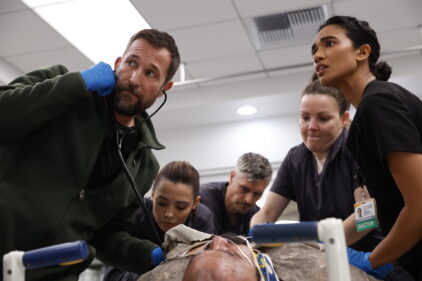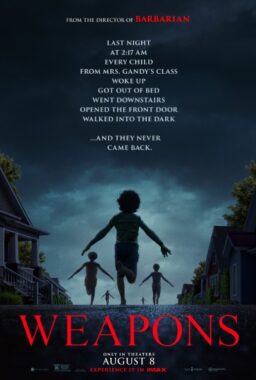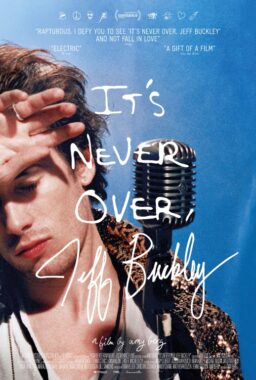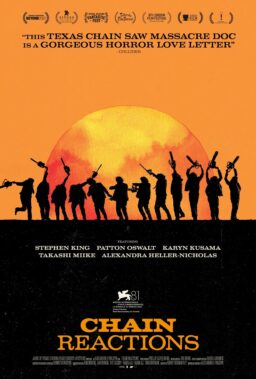Kino Lorber released five of Spike Lee’s films from the 1990s last week, some of them landing on Blu-ray for the very first time. The releases allow a look back at an incredible run, a series of films that only now feels like it’s really getting the attention it deserves. Of course, 1989’s “Do the Right Thing” was long ago elevated to the Great Movies pantheon in which it belongs, and 2002’s “25th Hour” has a vocal, devoted fanbase. The films in between, with the exception of 1992’s “Malcolm X,” have largely not been given the reappraisal they deserved long ago. Watching five of them in a row left this fan of Spike Lee even more in awe of his ambition, creativity, and passion. These are five New York stories told in a way that only Spike Lee could tell them, and they work together in a way that illuminates the growth and brilliance of one of the best American filmmakers of all time. In chronological order:

“Mo’ Better Blues” (1990)
Coming on the heels of “Do the Right Thing,” critics and viewers didn’t really know what to do with a film that’s very different in tone and structure from Spike Lee’s breakthrough. If his 1989 classic was driven by the rap beats of Public Enemy, his follow-up is structure more like a classic jazz composition, repeating themes but also willing to spin off into digressions that feel like a great trumpet player improvising in the moment. A film that felt kind of messy in 1990 now feels risky and daring in ways that make it feel almost fresher three decades after its release.
Lee directs Denzel Washington to arguably his most underrated performance as Bleek Gilliam, a trumpeter prone to making bad decisions. Playing shows with the Bleek Quintet has made Gilliam something of a star, but he has trouble juggling not just the personalities who share the stage with him but how to balance his art with his two girlfriends, Indigo (Joie Lee) and Clarke (Cynda Williams). Most of all, nothing gets in the way of his trumpet. (There’s a great beat when a lover bites his lip, which is the worst thing you do to a trumpet player.)
Watching it again three decades after its release, it’s easy to be struck by how confidently Lee worked with ensemble even this early in his career. Washington is magnetic, but the whole cast clicks, including some of the best work in the careers of Wesley Snipes and Giancarlo Esposito. At this time, Lee was developing a rapport with a cast he would work with repeatedly, and it’s invigorating to see everyone committing their all to this project, creatively inspired by one another like a great jazz act. And then there’s the score from another person who would become a regular collaborator, Terence Blanchard, doing some of the best work of his career. “Mo’ Better Blues” is magnetic and mesmerizing, as remarkable in its messy, inconsistent moments as it is in its perfectly polished ones.

“Jungle Fever” (1991)
If “Mo’ Better Blues” has aged in a way that makes it feel underrated in 2020, his follow-up has arguably gone a bit in the other direction. However, despite some of the flaws of this drama, particularly in the final act, there’s enough to like here to warrant revisiting it, including a reminder how charismatic Wesley Snipes and Annabella Sciorra could be in the right material. But one of the reasons the film feels imbalanced now is because the breakthrough performances by Samuel L. Jackson and Halle Berry dominate even more than they did on initial release given the careers they would follow this up with. The story of a black man and a white woman navigating the racial undercurrents of their affair simply aren’t as engaging as Jackson’s breakthrough as a crack addict willing to do anything to feed his addiction. And the two halves—the story of race relations and the story of crack taking over and destroying black families—never feel like they coalesce into one picture.
Having said that, if this is the worst of a five-film set you’re thinking of buying, it’s a damn strong set. Tonally and structurally, “Jungle Fever” feels like an extension of “Mo’ Better Blues,” as Lee is once again playing more instinctual and organic storytelling structure than anything predictable. Lee’s best films are tapestries, filled with multiple interesting characters working together to form a complete piece. If the entire tapestry here doesn’t come together, there are still stunning individual pieces within the tapestry—decisions made by the cast, wonderful exchanges of dialogue, and, of course, all that Stevie Wonder music.

“Crooklyn” (1994)
One of Lee’s most personal and touching films is this period piece that he co-wrote with his sisters Joie and Cinqué Lee. Lee really started exploring period drama with “Malcolm X”—the five films before that were contemporary—and his masterful work there opened him up to new ideas in storytelling, ably assisted by regular collaborators like Terence Blanchard and Ruth Carter’s magnificent costume design. The final section of “Crooklyn” feels a little manipulative in ways that Lee isn’t often, but there’s so much to like before then, including incredibly underrated performances from two of our most incredibly underrated performers, Alfre Woodard and Delroy Lindo.
The two play parents of a large family, whom we see largely through the eyes of Troy (Zelda Harris) in Brooklyn in 1973. Life with Troy, her four brothers, her strict mother Carolyn (Woodard), and her musician father Woody (Lindo) is sketched episodically by Lee and his sisters, but the impact here isn’t through the narrative as much as it is the transportive nature of the period recreation. The splash of water from the fire hydrants, the sound of playing children, the music of a soundtrack that only includes music of the era—every element of “Crooklyn” was clearly very carefully considered, and yet the film never loses Lee’s organic style that values character and personality above all else.

“Clockers” (1996)
A brilliant study of the tiers of the drug trade driven by great performances by Mekhi Phifer, Harvey Keitel, and Delroy Lindo, “Clockers” remains one of Lee’s most ambitious movies, in part because of the way he melds his voice with that of Richard Price, who wrote the book and co-wrote the screenplay. There’s such a bone-weary tiredness in much of “Clockers,” including the somber score by Terence Blanchard—this is a world that’s bringing everyone down from the dealers to the cops to the community caught in the middle. It’s even eating our ulcer-ridden protagonist from the inside out. It’s the story of a shooting investigation in the criminal world of clockers, or drug dealers in Brooklyn, but that’s just the catalyst for a study of a community and a criminal enterprise that turns children into murderers.
With the exception of including smartphones and shooting on digital, “Clockers” could be released largely unchanged today. This is before “The Wire,” and the slate of films and TV shows about the drug trade that would follow in that show’s wake. It is also feels more like a turning point for Lee socially than it first did, now that we’re able to look back at his career. It’s a movie that opens with shots of bloodied black men on the pavement and closes with another body found in a park, and, again, it feels more somber and almost resigned than angry—aware that there’s not much we can do about this broken system that turns kids into criminals, when they’d be much happier playing with model trains. The film doesn’t quite stick the landing—finding the right closing note was Lee’s greatest problem in the ‘90s—but it arguably feels more ahead of its time than anything from this era. The model and physical train in the movie feels both like a symbol for escape, and it’s definitely that for its protagonist in practical terms, but also for something that can’t be stopped, and always runs on time.

“Summer of Sam” (1999)
Spike Lee closed the ‘80s with a masterpiece about a summer in which violence erupted in a New York community, and he did the same to end the ‘90s with this widely misunderstand drama, one of the most ambitious movies Lee has ever made. Instead of merely chronicling the crimes of the Son of Sam in New York in 1977, Lee makes a film that’s a tapestry of that summer, one in which violence seems to be bubbling under everything that happens. It’s almost as if David Berkowitz is merely a manifestation of everything going on in the city at the time, and Lee reflects this through everyone but the actual serial killer, focusing more on people who lived in the community he terrorized instead of the man himself. “Summer of Sam” is imperfect and rough-edged, but has also held up remarkably well, thanks in part to John Leguizamo’s best screen work but mostly because of Lee’s incredible attention to detail and the way it values setting over plot. It’s a film in which you can feel the heat and smell the streets, as unpredictable as life in NYC in the summer of the blackouts and the murders was for the people who lived there.
People responded negatively to “Summer of Sam” more for what it wasn’t than what it was. The setting and subplot naturally interested true crime fans who found a movie that investigates fear more than details the sins of a serial killer. It’s a film about violence and sex and fear of the other more than anything else, and it’s a wonderful illustration of how Lee developed in the decade between “Do the Right Thing” and “Summer of Sam.” He made a movie that’s a reflection of his breakthrough, another hot summer of violence, but that also has a very different language and focus. He began the decade as a promising young filmmaker, and he ended it as one of the best chroniclers of New York City in the history of the form. And, in many ways, he was just getting started.

